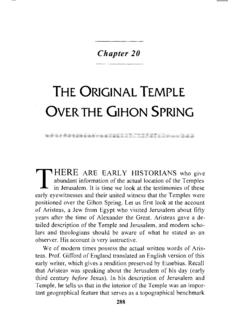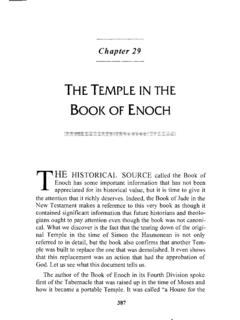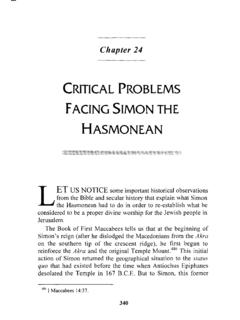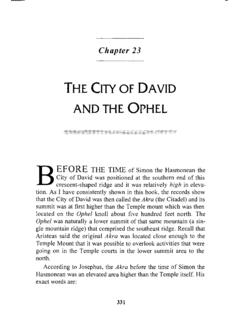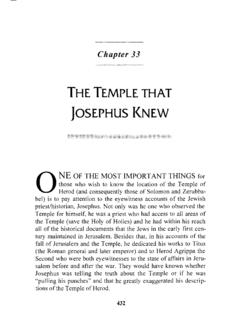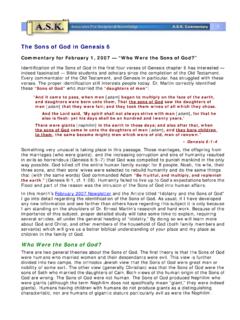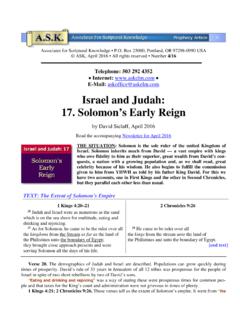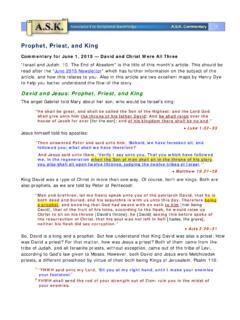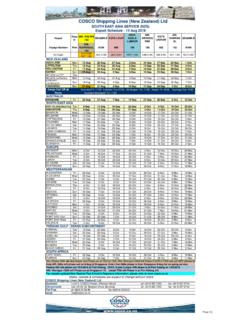Transcription of Ancient Canal in Egypt - Biblical Research
1 Bitter Lakes area An Ancient Canal in Egypt Commentary for January 16, 2012 The Original Suez Canal I enjoy being surprised by new information about Ancient history. I recently learned about a well-attested Ancient Canal for transit that existed between the Mediterranean Sea and the Red Sea. There is a great deal of information in Ancient writings. Since earliest times Egypt used sophisticated canals for irrigation along the Nile River and the Nile Delta. The purpose of these canals was to maximize and extend the life-giving fresh water and silt of the Nile River to as great an area as possible. Egypt in antiquity also had larger canals that linked the Gulf of Suez and the Nile River tributaries, and from there to the Mediterranean Sea. The Greek historian Herodotus in the 4th century BC wrote about the con-struction of one of these transport canals (there were others over the centuries). It was begun by a Necos or Necho. Necho is mentioned in the Bible in 2 Chronicles 35:20, 22, and 36:4, where Necho is not called Pharaoh but king.
2 Herodotus wrote: Psammetichus had a son, Necos, who became king of Egypt . It was he who began building the Canal into the Red Sea, which was finished by Darius the Persian. This is four days voyage .., and it was dug wide enough for two triremes to move in it rowed abreast. It is fed by the Nile, and is carried from a little above Bubastis by the Arabian town of Patumus; it issues into the Red Sea. Digging began in the part of the Egyptian plain nearest to Arabia; the mountains that extend to Memphis (the mountains where the stone quarries are) come close to this plain; the Canal is led along the foothills of these mountains in a long reach from west to east; passing then into a ravine, it bears southward out of the hill country towards the Arabian Gulf. Now the shortest and most direct passage from the northern to the southern or Red Sea is from the Casian promontory, the boundary between Egypt and Syria, to the Arabian Gulf, and this is a distance of one hundred and twenty five miles, 2 neither more nor less; this is the most direct route, but the Canal is far longer, inasmuch as it is more crooked.
3 Herodotus, Histories 51 The Egyptian army of Necho II killed King Josiah of Judah in battle at Megiddo in the 5th century BC (2 Kings 23:29 30; 2 Chronicles 35:20 24). Note the phrase the mountains where the stone quarries are .. These stone quarries are in the north of Egypt . They are well known. They are the source of the great stones used in some of the monumental structures of A Canal from the Nile to the Red Sea facilitated boat or ship trade to Arabia, to Eilat in Israel (in the north of the Gulf of Aqaba), to the lands of the Persian Gulf, and even to India. This Canal by Necho and Darius was not the first connection made by the Egyptians. Historian How comments: The Nile Canal was first made by Sethos I (nineteenth dynasty, 1326 1300 BC; cf. Petrie, iii. 13); it was represented in one of the scenes in the hall at Karnak. It had, however, silted up by Necho s time. The work of Darius is confirmed by inscriptions (Hogarth, A. and A.)
4 P. 184) found between the Bitter Lakes and the Red Sea; Darius says, I ordered to dig this Canal from the Nile which flows in Egypt to the sea which begins with Persia. This Canal was dug (Weissbach and Bang, 1893); .. The Canal was again rendered navigable under the Ptolemies, and with some vari-ation of direction by [Roman Emperor] Trajan (but this is uncertain); it finally was closed in the eighth century AD [when Egypt was ruled by the Arabs]. The remains of the Canal at Belb s show that it was some 50 yards wide and 16 to 17 feet deep; cf. vii. 24 (the Mount Athos Canal ) for the breadth two triremes abreast . 3 How, A Commentary on Herodotus, vol. 1, p. 246, underlines mine 1 Herodotus, Herodotus, With an English Translation by Godley (Medford, MA: Harvard Univ. Press, 1920), p. 246. 2 Discovery of an earlier Canal was announced in the October 2007 article Canal Linking Ancient Egypt Quarry to Nile Found from a National Geographic website news article.
5 This Egyptian Canal was in southern Egypt , drawing from different quarries than those near Memphis in the north. The article states that these stones from the southern canals were used to build the pyramids near the beginning of the Nile Delta. 3 How, A Commentary on Herodotus (English), vol. 1 (Medford, MA: Perseus Digital Library, 22 June 2000), 246. 3 Herodotus lived about 50 years after Darius completion of this Canal . This Darius I, also known as Darius the Great, was the king who expanded the Persian Empire to its greatest extent. He was also the first Persian ruler to invade Greece, and fail. He was also a great builder. According to Herodotus, under Necho a hundred and twenty thousand Egyptians died digging it. The inscription of Darius celebrating the completion of the Canal is extant: King Darius says: I am a Persian; setting out from Persia, I conquered Egypt . I ordered to dig this Canal from the river that is called Nile and flows in Egypt , to the sea that begins in Persia.
6 Therefore, when this Canal had been dug as I had ordered, ships went from Egypt through this Canal to Persia, as I had intended. Darius Suez Inscriptions 4 The Ancient Canal allowed passage from the Mediterranean Sea to a Nile Delta tributary, then through the Canal to the Bitter Lakes, then south to the Gulf of Suez. The current Suez Canal dug and opened by the French in 1869, goes directly from the Mediterranean north to south to the Gulf of Suez for 120 miles. Ancient Egypt first made a Canal to connect the Mediterranean Sea to the Red Sea via the tributaries of the River delta of the Nile. The first who dug it was Senausert III, Pharaoh of Egypt , 1874 BC. This Canal was abandoned, silted up, was re-dug, and later reopened several times (Source: Suez Canal : Canal History webpage). Here is additional history of the reopenings and the last closure of the Canal . These editions may not have had the same route: Canal of Sity I 1310 BC Canal of Nkhaw 610 BC Canal of Darius I 510 BC Canal of Ptolemy II 285 BC Canal of The Romans 117 AD Canal of Amir El-Moemeneen 640 AD Canal silted in during reign of Abbasid caliph El-Mansur 767 AD There may be other periods where the Canal was rebuilt.
7 It was obviously desirable for the Canal to be open and not good for it to be This means that for several periods of Ancient history a Canal opened transport from the Mediterranean Sea to the Gulf of Suez and beyond. During the time of Ptolemy II the Canal even had locks on the Canal to raise and lower water level for the boats: At each mouth [of each Nile tributary] is a walled city, which is divided into two parts by the river and provided on each side of the mouth with pontoon bridges and guard-houses at suitable points. From the Pelusiac mouth there is an artificial Canal to the Arabian Gulf and the Red Sea.. At a later time the second Ptolemy completed it and in the most 4 Actually Darius is boasting; his predecessor, Cambyses, conquered Egypt . 5 It is interesting that when Greek authors began to compile lists (there were several lists) of the 7 wonders of the Ancient world in the 1st century BC, this Canal is never listed.
8 4 suitable spot constructed an ingenious kind of a lock. This he opened, whenever he wished to pass through, and quickly closed again, a contrivance which usage proved to be highly successful. The river which flows through this Canal is named Ptolemy, after the builder of it, and has at its mouth the city called Arsino . Diodorus Siculus, The Library of History, 12 Regarding Ptolemy s Canal , besides Diodorus Siculus, the Greek historian Strabo (d. 23 AD), and the Pithom Stele for Ptolemy s regnal year 16, all mention the achievement of the Canal s completion. Other mentions of a different Canal are by Aristotle, Pliny the Elder, and again Strabo. Professor Morris Silver of the City College of New York has an excellent article about these constructions. He wonders that the Canal may have a relationship to the Exodus account, Ancient Economies II, giving many Ancient sources on his webpage. I am uncer-tain about this evidence, although it is possible that the route of the Exodus came near to the Canal .
9 Israel s and Judah s Merchant Navy When King Solomon ruled the unified Kingdom of Israel, he built merchant ships, assisted by the neighboring Kingdom of Tyre who supplied trained manpower to assist in the construction and operation of the ships: King Solomon built a fleet of ships at Eziongeber, which is near Eloth on the shore of the Red Sea, in the land of Edom. And Hiram sent with the fleet his servants, seamen who were familiar with the sea, together with the servants of Solomon; and they went to Ophir, and brought from there gold, to the amount of four hundred and twenty talents; and they brought it to King Solomon. 1 Kings 9:26 28 Eziongeber is close to Eloth. Eloth today is the city of Eilat at the north of the present day Gulf of Aqaba (then part of the Red Sea, see the map) at the southern tip of modern Israel. Second Chronicles gives a somewhat different account: Solomon went to Ezion-geber and Eloth on the shore of the sea, in the land of Edom.
10 And Huram sent him by his servants ships and servants familiar with the sea, and they went to Ophir together with the servants of Solomon, and brought from there four hundred and fifty talents of gold and brought it to Solomon. 2 Chronicles 8:17 18, Revised Standard Version This Chronicles passage seems to say that the ships were sent to Solomon from Phoenicia to Ezion-geber. Did they sail around Africa? That is unlikely. Perhaps (and I do not know) a few ships with cargoes of timber may have sailed from Phoenicia, gone through the Egyptian canals to the Red Sea, then to Ezion-geber. There they built more ships with the wood. They had a separate fleet on the Mediterranean side (1 Kings 10:22 & 2 Chronicles 9:21).6 David Sielaff 6 King Jehoshaphat, the 4th King of Judah, also built ships in Ezion-geber, compare 1 Kings 22:48 and 2 Chronicles 20:35 37. God wrecked them there.

